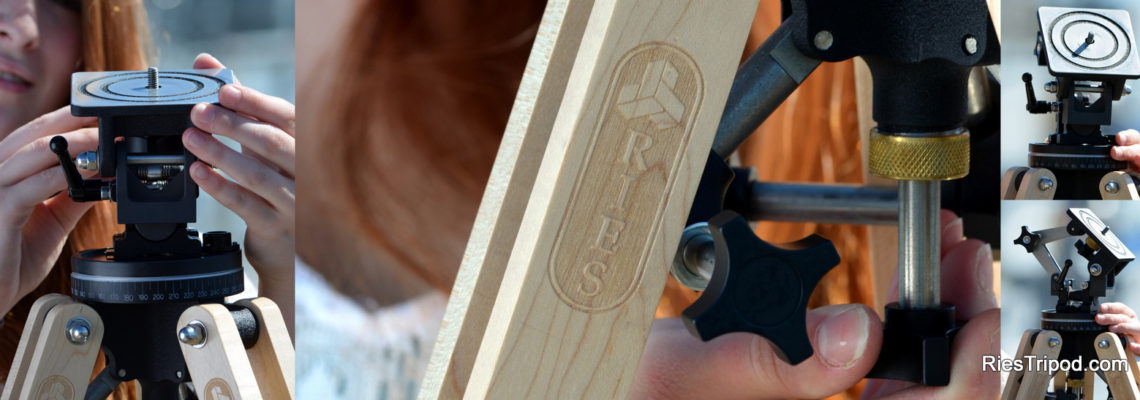
Ries Wooden Tripod Offers…
Lightweight Durability- When it comes to tripods, all the advances of modern technology have yet develop an alloy or synthetic material that offers the lightweight durability of wood. The Ries wooden tripod frequently weighs less than its metal alloy counterparts, and wooden legs make the Ries wooden tripods impervious to the elements. Further, the very nature of wood makes the tripod absorb and mute work-threatening vibrations rather than exaggerate and transfer them to your equipment. Ries Wooden Tripods are specifically made from “tone woods” or AKA; “tonewoods”, (look it up).

Ease of Use- A quick knob turn fully releases each leg for setup. Both massive and minuscule leg adjustments are easily accommodated. Ries’s patented Tri-Lock feature individually secures each leg into precise position, eliminating the need for any additional equipment to stabilize the tripod. The simplicity of the Ries hardware is the key to its success.

Quality- Ries Tripods are crafted of top-grade hardrock maple, hand-finished, and assembled using precision custom hardware designed exclusively by Ries. Each Ries tripod is individually inspected to ensure that it maintains the rigid standards required of a Ries product.
Custom Capability- Do you prefer rosewood with bronze hardware over hardrock maple with black anodized hardware? Do you want wood’s durable qualities but prefer a high-tech finish over natural wood tones? Are you mounting a telescope rather than a view camera? Because all Ries products are hand-crafted, we can accommodate your custom specifications.
The Ries Beginning
In 1930 Branching into the tripod manufacturing business was a logical step for the Ries brothers— being involved in filmmaking, they knew what made a suitable tripod. Park, Paul, and Irving had the necessary skills to design and manufacture, and their profile in early Hollywood gave them the connections to market the product. Ries tripods have always been crafted one at a time from wood, which provided an important edge in the marketplace. Westerns were extremely popular at the time the tripods were introduced, and tripods made of wood were much more comfortable to handle than metal in the hot desert locations often selected for filming. Ries tripods are still built according to these specifications today.

The early Tri-Lok tripod patented by Paul and Park Ries had metal fittings that came into contact with the crown (also called the top plate) and prevented the legs from collapsing during use. This feature in itself was a breakthrough. Park further improved the tripod in 1950 by developing and adding the current version of the patented Tri-Lok braces, which lock solidly into place. Often a tripod’s unbraced center post introduces camera vibration, but Ries tripods have never had a center post, which makes them more stable. This stability is one reason that, even today, Ries tripods are often specifically called for in testing of electronic equipment.

During the Second World War, wood was not a strategic strategic material, while aluminum was in demand for aircraft and other military uses, so Ries continued production uninterrupted during World War II, although most of the company’s production was for use by the armed forces. Ries products have always been made in America, and from the company’s beginning, Ries has always been known by professional photographers for outstanding customer service.  These tripods also appeal to serious art photographers because the wood used in the tripods’ manufacture has a natural “warmth” and beauty that inorganic materials simply lack. A scuffed Ries tripod can easily be retouched if the owner wishes to keep his or her tripod looking like new.
These tripods also appeal to serious art photographers because the wood used in the tripods’ manufacture has a natural “warmth” and beauty that inorganic materials simply lack. A scuffed Ries tripod can easily be retouched if the owner wishes to keep his or her tripod looking like new.

I initially undertook writing this article simply to reconstruct the history of the Ries tripod, which is still manufactured in Bremerton, Washington, by Ries Productions and remains a preferred instrument f or photographers worldwide. However, in the process I uncovered the story of the Ries brothers themselves and how their work in the early days of the film industry influenced the development of the Ries tripod. Unfortunately, while the tripod lives on, the Ries brothers have been largely overlooked by history. The following timeline provides a look at the brothers’ contributions to the development of the film industry in early Hollywood, as well as the evolution of their iconic tripod.
or photographers worldwide. However, in the process I uncovered the story of the Ries brothers themselves and how their work in the early days of the film industry influenced the development of the Ries tripod. Unfortunately, while the tripod lives on, the Ries brothers have been largely overlooked by history. The following timeline provides a look at the brothers’ contributions to the development of the film industry in early Hollywood, as well as the evolution of their iconic tripod.
Click Here To read The Ries Brothers History
All Performances are based on Ries models manufactured after January 2014 when the Ries factory converted from cast aluminum to the current wrought 6061-T6 aluminum alloy. Though similar in appearance to the older cast aluminum the older Ries models are not rated to the same specifications as our newer models.













